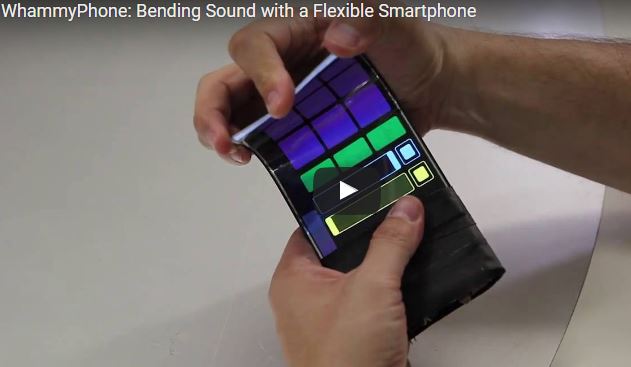
She pushed down hard on the rectangular phone and, like a slap bracelet, it cinched around her wrist. The audience gasped; the internet went wild.
This articulated, gasp-inducing, wraparound phone — known as the CPlus — was a concept device Lenovo used to wow the crowd as part of a larger launch last June that included the modular Moto Z and Phab 2 Pro (the first phone using Google’s Tango software for augmented reality). The CPlus may have only been a prototype, but it might as well have been a fireworks show for the imagination it ignited about the future of truly flexible phones that can bend and even fold.
As powerful as today’s phones are, their rectangular reliability has become a boring and invisible necessity that we hardly see at all. And that’s why handsets that bend, twist, snap and fold will electrify and energize the industry, even if these newfangled future devices limp and lag at first.
Why would we want a bendable or foldable phone?
Flexing, folding handsets are visually and intellectually cool because rigid electronic pieces usually don’t bend, at least not without a hinge. But is there an actual use for them beyond pushing the boundaries of what designers and scientists can do?
Actually, there are a few. Folding a device gives you a smaller, more portable package to carry around — it can essentially double the size of your screen.
In addition, devices like these “will be able to be produced like newsprint,” said Roel Vertegaal, who directs the Human Media Lab at Canada’s Queens University and works on prototype models. Producing some phone parts this way could eventually make the phones cheaper to build, he added.
Shapely devices that give you more of a shifting 3D work surface (rather than a constantly flat screen) also have the power to change how people carry and even use them, like navigating in new ways while playing a game, or using the way you bend a device to trigger an action, like when playing a game or creating sound (see video above).
Few, far between and potentially flawed
Lenovo’s pill-bug phone isn’t the only one to stretch the boundaries of flexible devices. In fact, twistable phone prototypes are something we were seeing as far back as 2011. In the past months, Samsung applied for a patent application on a foldable phone, which means it’s likely to take the curved-screen (but static) Edge handsets to the next level soon, and LG Electronics is rumored to be supplying Apple, Google and Microsoft with flexible phone displays in 2018. Lenovo, too, is working on a tablet prototype that folds down to make a smaller overall package. The company briefly flashed it to journalists at the same time it showed off the wraparound CPlus.
But while research on flexible and foldable phones is heating up in corporate and private labs, don’t expect to see them everywhere at once. Companies tend to go slowly and cautiously with radical new designs.
Take Samsung’s first curved-screen phone, for example. The Galaxy Round was essentially a concept phone that never left South Korea, but its design morphed through several iterations to arrive at today’s S7 Edge with its two curving sides. Xiaomi’s nearly bezel-less Mi Mix is also another concept device whose technology will show up in other handsets down the line. It’s likely that the first of these futuristic, flexible phones will:
There’s also wear and tear to consider on phones you repeatedly fold and bend. “[I] don’t see why I’d like my phone to bend and in fact, have put it in an OtterBox to protect it from the daily abuse it has to endure,” said Chris Schmandt, who directs the Living Mobile Group at MIT’s Media Lab.
It’s possible, too, that a new, more flexible design could affect the kind of hardware you can put into a device, say, a smaller battery than you can stick in a large, flat rectangle. It’s also likely that rigid parts, like circuit boards, will have to use a different internal configuration, or be made to slightly bend as well.
The drive to get there first
So if bendable and flexible phones aren’t guaranteed to be a smash hit, why would companies pour cash into R&D for phones that may not go mainstream for years, or even ever? The truth is, we can’t always accurately predict which trends will catch on and which will go thud.
lg-g-flex-2-0212.jpgEnlarge Image
LG’s G Flex 2 actually flexed when you pressed it down, but LG seems to have discontinued the line.
Photo by Josh P. Miller/CNET
But there is a certain glory in innovating first, and there’s a distinct market advantage for companies that have the most experience if and when flexible and bendable gadgets take off.
(Samsung in particular might benefit here if it’s first to release its foldable electronics. “Samsung will likely take the ‘disruptive’ road back to the market,” said Wayne Lam, an analyst with IHS Markit, “And hopefully put the Note 7 fiasco behind them.”)
What excites me most, though, is that this type of innovation helps phone makers everywhere build on past discoveries to propel new ones. It is, after all, only through trial and error that the industry collectively figures out what works and what doesn’t. It’s the kind of development that will give us the next tech we can’t live without, the same way that the passion to miniaturize a desktop computer brought about the smartphone tucked into your pocket right now.
END

Be the first to comment